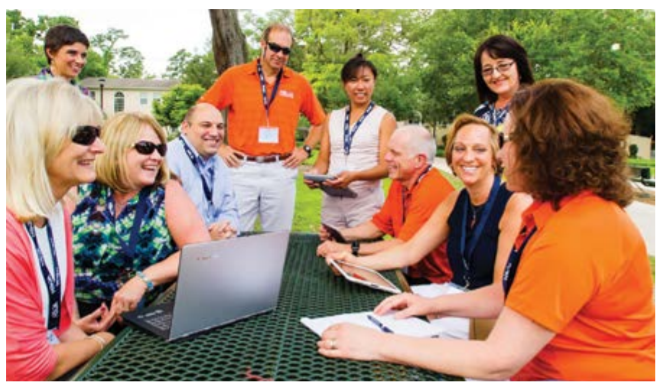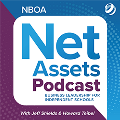Interview by Kelly Clark, Association Adviser
This is an edited version of an interview published originally in Association Adviser.
Eight years ago, NBOA was a much smaller association (700 member schools, compared to more than 1,300 today) whose primary focus was consulting to a small number of schools. Other than the magazine, annual meeting and webinars, most members received little association support. Shields led the effort to reimagine NBOA as an organization that provides education and professional development to all members throughout the year.
Association Adviser: What do you do to build a partnership in your organization?
Jeff Shields: First and foremost, as soon as I started the NBOA job, I interviewed every board member. What was working well? What needed improvement? What were key issues we needed to work on? I think they liked that I asked. I invested a lot of time in getting to know our board and the issues important to them.
I include staff in more board communications so the work of the board is not a mystery to them, and they understand why I give it so much attention.
Then I began sending monthly reports to my board that provided brief updates on association initiatives. We only meet face-to-face three times per year, but I want to keep them engaged every month of the year. I think CEOs and boards benefit from open communication, so I share what’s going on, keep them up-to-date and share what’s not working well – this brings them close to the work of the association in an authentic way and creates a relationship where they want to be your ally and source of support. I also include the staff in more board communications so the work of the board is not a mystery to them, and they understand why I give it so much attention. Positive things then happen. I think sincere interest, listening and being responsive really develops the relationship with your board.
AA: What were some issues that needed improvement at NBOA?
JS: We needed to recruit more members; membership growth hadn’t been addressed in a significant way in some time. NBOA didn’t have a lot of money. I, along with staff, had to figure out how to generate more revenue for our association with a shoestring budget. At the same time, we needed to improve board governance because when you have financial issues, boards get in the weeds. So, it was important to build confidence in the board that the staff and I had strategies to move us forward.
Anything we knew was of high value to members we used to attract more members. When it comes to membership growth, you’re only as good as the data in your membership database, so we populated our potential member database with good data from non-member schools.
When it comes to growth, you’re only as good as the data in your database, so we populated our database with good data from non-member schools.
Then we leveraged everything that NBOA did well. For example, we held great webinars, but we didn’t have many attendees. We had an annual meeting with great programs, but we did not have a lot of exhibitor or sponsor support. To earn more revenue, we expanded our business partner universe and allowed non-members to exhibit at events. We increased the fee differential between members and non-members for webinars and professional development programs. We added two additional issues annually to the magazine and made it a members-only publication. Soon, we had more than 100 schools join because they wanted access to the publication. That seems like a small reason to become a member, but thankfully it worked because that is what we had to work with!
Finally, we had to adjust our association staff. That’s not a slight toward NBOA’s staff at the time, but we needed to attract more association expertise and different skills, like marketing, to the existing staff. I was dialed into the association network due to my involvement with ASAE, so I knew what kind of talent we needed. To have greater access to association talent, we moved NBOA’s headquarters to Washington, D.C. We added some positions and eliminated others that weren’t necessary for the direction in which the association needed to go.
None of these changes were easy, but all were necessary and thankfully our board knew that. The relationship with the board has become one of my greatest assets as CEO. Although, I don’t have a vote on the board, the board asks my opinion about issues and new directors serving on the board, and they particularly value my opinion on the board chair. They know how critical it is to have a board chair who will develop a strong partnership with the CEO. Everyone – directors, staff and members – pays the price in poor association performance if there is not a strong partnership.
AA: NBOA was founded in 1998 and could be considered a young association. Was that a factor in your growth challenges?
JS: Yes, we are young! And that comes with disadvantages and advantages. The main disadvantages for us were the lack of a large budget and established offerings.
We are a “digital native,” so we didn’t have to get members used to communicating digitally; we immediately started using that tech in daily work life.
But we had some technology advantages that older associations struggled with. For example, by 1998, associations were starting to use websites and listservs to inexpensively communicate with members, instead of direct mail. NBOA started using that tech right away. We are a “digital native,” so we didn’t have to get members used to communicating digitally because we immediately started using that tech in daily work life.
We also didn’t have any “sacred cows” that weren’t working for us but stuck around because they were traditions. We were able to experiment and take risks, and we still experiment with what we do. If something is successful, we see how we can replicate it. If it’s not successful, we walk away.
AA: You reorganized your staffing model from one that could effectively serve a few members to one that could efficiently serve many. What kind of resources/investment did that take?
JS: At the time I became CEO, our association was mostly staffed with former business officers. They would visit schools and consult on business practices. This was fine, but we were serving, at best, 12 schools in one year really well and barely serving any other member schools. We had no bandwidth to expand our value proposition and promote membership growth. We really needed to flip that paradigm, and to do that, our staffing model needed to change.
We moved away from our consulting practice because it was a significant drain on staff resources. Consulting is time-intensive. Instead, we moved toward developing ways of serving the larger NBOA membership. We expanded the magazine’s content and frequency. We started offering member webinars for free – 14 per year that focus on both technical and “hot topics.” We developed online courses. None of these strategies require staff to show up at your school. We collaborated with state and regional associations on road shows to meet more members face-to-face. We also created a biweekly eNewsletter related to independent school operations. With all of these tactics, our goal was to increase the number of touches schools receive from us without us having to show up. So, we transitioned from a very high-touch model serving a dozen schools, to a high-touch model now serving more than 1,300 schools in the U.S.
AA: What kind of feedback did you get from these changes?
JS: We were such a small enterprise that, at the time, it wasn’t hard to dial those services back without getting much negative feedback. We still got consulting requests, and there were some growing pains to getting out of that line of business, but it was more important for us to ramp up our visibility to a growing membership and get into other areas of member services. The vast majority of our members thought we were doing more, not less, because the number of programs where members got to see us grew.
AA: Did NBOA’s board oversee these new programs? What was their reaction?
JS: All of this happened at a time when the board went from managing to governing. The 22-member board was previously managing programs, but as we saw enhanced programming success and saw the domino effect it was having on growing membership, growing participation in events and growing content on website, they pivoted to more of a governing board.
As we saw enhanced programming success and growing membership, participation in events and content on website, the board pivoted from managing to governing.
The board that hired me in 2010 understood better than anybody the financial challenges the association had. The board understood we needed a sea change. I think seeing those early indicators that we were growing helped clear the runway for the board to give me greater latitude in how we were growing staff and programming. To be clear, all ideas for new programming or events go through the board via discussion because it all costs money and – to be sustainable – must be linked to strategy. The changes I was proposing were quick ones that gave NBOA some early successes and that aligned with our strategy and plan at the time, so the board was supportive.
In any organization, the CEO gets more than his fair share of credit for its success and more than his fair share of blame if something goes wrong. But I want to be clear: At NBOA, our success is such a team effort, which makes it all the better. We all know that it took every person on our staff team to get where we are today. We’ve been able to grow that team so we can share successes with more people. In 2010, we had nine full-time employees; now we’re at 17 FTE in eight years. Our membership has doubled, too. We had 700 in 2010 and now we’re at 1,365.
AA: What keeps you up at night?
JS: It’s the job of every association to maintain a connection, value and relevance with its membership and with the industry it serves. Change happens so fast. Are we keeping pace with that change? And keeping pace with members? In this environment, no one can rely on their last success. You must constantly build and work toward the next one. I think associations that have a strong connection with members will continue to thrive, but it’s getting harder to justify that connection because of how easy it is to use the internet and social media to get information on your own. Associations really have to pay attention to member signals and build in relevance and connection with everything they do. Our present and future competition is not from other associations but other sources of information and ways to network.



